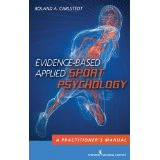“Evidence-Based Applied Sport Psychology: A Practitioner’s Manual”

“Evidence-Based Applied Sport Psychology: A Practitioner’s Manual”
By Roland A. Carlstedt
Springer Publishing Company, LLC
New York, N.Y., 2013
‘Opus’ manual is challenging and complex
Reviewed by James K. Luiselli, Ed.D., ABPP, BCBA-D
Sport psychology is dominated by behavioral and cognitive strategies, some of them evidence-based and empirically supported, but not always adopted in routine professional practice. This book is a manual that is intended to “expose practitioners, educators, and students to an integrative, interdisciplinary and systematized approach to athlete assessment and intervention.” The author, Roland A. Carlstedt, has pioneered the development of effective performance enhancement methods including the highly praised American Board of Sport Psychology – Carlstedt Protocol (ABSP-CP).
From the onset, I caution the reader that the manual is a 500+ page opus which is challenging, complex and not easily accessible by the novice sport psychology clinician. Carlstedt is committed to translating the most rigorous research data into successful assessment and training procedures such as psychophysiological stress testing, quantitative electroencephalography, heart rate variability monitoring, cerebral laterality manipulation and various types of biofeedback. You get the picture: this is cutting edge stuff that takes time, effort, and more than a little background knowledge to fully digest!
One of Carlstedt’s fundamental points is that sport psychology practitioners must assess certain baseline measures with athletes before making recommendations and designing training routines. Where things get dicey is that some of these measures encompass “frontal lobe error rate” and “movement-related brain-macro potentials” and “heart rate variability and deceleration response parameters.” I do not know any practitioners, myself included, that are intimately familiar with these indices let alone how to assess them. I am persuaded by what Carlstedt has to say and proposes but transferring the many methodologies into practice is another matter. In fact, it is likely that a team of sport psychology professionals would have to be assembled to properly assess, train and evaluate an individual athlete.
The manual is not shy about criticizing conventional sport psychology practices and many sections address perceived deficiencies. For example, Carlstedt opines that “the guru-driven nature of sport psychology has contaminated the field,” feeling most practitioners rely on poorly validated methods, intervention procedures are applied haphazardly and sport psychology services are mostly focused on the needs of practitioners and not athletes. What he says is true on many counts and will certainly stimulate debate and controversy within the field.
You will need to know a great deal about psychophysiology, statistical analyses, neurocognition, brain science and psychometrics to get the most out of this manual. Although Carlstedt targets “grass-roots practitioners on the front line of applied sport psychology,” I think it safe to say that his work and scholarship will resonate strongest with highly advanced and experienced sport psychologists, many of whom consult with elite athletes. And yet, if you are interested in sport psychology on any level, the manual is well worth the cost and investment of time. Notably, the sections about integrative athlete assessment, critical issues in applied sport psychology and achieving board certification as a sport psychologist will be most relevant to the largest audience.
James K. Luiselli, Ed.D., ABPP, BCBA-D, is senior vice president, applied research, clinical training and peer review at the May Institute in Norwood, Mass.
Learn more about the book: Evidence-Based Applied Sport Psychology: A Practitioner's Manual
